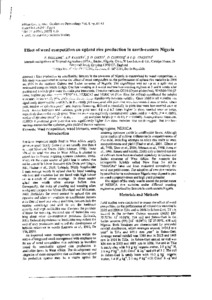| dc.contributor.author | Ekeleme, F. |
| dc.contributor.author | Kamara, A.Y. |
| dc.contributor.author | Oikeh, S.O. |
| dc.contributor.author | Chikoye, D. |
| dc.contributor.author | Omoigui, L.O. |
| dc.date.accessioned | 2019-12-04T11:14:17Z |
| dc.date.available | 2019-12-04T11:14:17Z |
| dc.date.issued | 2007 |
| dc.identifier.citation | Ekeleme, F., Kamara, A.Y., Oikeh, S.O., Chikoye, D. & Omoigui, L.O. (2007). Effect of weed competition on upland rice production in northeastern Nigeria. In 8th African Crop Science Society Conference, (pp. 61-65), 27-31 October, El-Minia, African Crop Science Society. |
| dc.identifier.uri | https://hdl.handle.net/20.500.12478/2717 |
| dc.description.abstract | Rice production by smallholder farmers in the savannas of Nigeria is constrained by weed competition. A field study was conducted to assess the effect of weed competition on the performance of upland rice varieties in 2005 and 2006 in the northern Guinea and Sudan savannas of Nigeria. The experiment was set up as a split plot in randomized complete block design. One hoe weeding at 3 weeks and two hoe-weeding regimes at 3 and 6 weeks after planting and a weedy plot were the main plot treatments. Five rice varieties CG14 (Oryza glaberima), WAB56-104 (O. sativa, tropical japonica, type), NERICA1, NERICA2 and NERICA4 (New Rice for Africa) constituted the subplot treatments. In the weedy plot, grain yield did not differ significantly between varieties. Grain yield in all varieties was significantly depressed by over 86% in the weedy plot compared with plots that were hoe-weeded once or twice. Grain yield, number of spikelets plant-1 and days to flowering, differed substantially in plots that were hoe-weeded once or twice. Across locations and varieties, grain yield were 4.8 and 6.7 times higher in plots weeded once or twice, respectively than in the weedy plots. Weed biomass was negatively correlated with grain yield (r=-0.70; P=<.0001), number of spikelets plant-1 (r=-0.40;; P=0.0060) and plant height (r=-0.41; P=0.0049). Averaged over locations, NERICA 4 produced grain yield that was significantly higher than other varieties. Our result suggests that two hoe-weedings are needed for optimum grain yield of the rice varieties. |
| dc.description.sponsorship | Canadian International Development Agency |
| dc.format.extent | 61-65 |
| dc.language.iso | en |
| dc.publisher | African Crop Science Society |
| dc.subject | Weed Competition |
| dc.subject | Biomass |
| dc.subject | Weeding |
| dc.subject | Rice |
| dc.subject | Smallholders |
| dc.subject | Yield |
| dc.title | Effect of weed competition on upland rice production in north-eastern Nigeria |
| dc.type | Conference Paper |
| dc.description.version | Peer Review |
| cg.contributor.affiliation | International Institute of Tropical Agriculture |
| cg.contributor.affiliation | Africa Rice Center |
| cg.coverage.region | Africa |
| cg.coverage.region | West Africa |
| cg.coverage.country | Nigeria |
| cg.authorship.types | CGIAR multi-centre |
| cg.iitasubject | Plant Production |
| cg.iitasubject | Smallholder Farmers |
| cg.iitasubject | Weeds |
| cg.howpublished | Formally Published |
| cg.publicationplace | El - Minia, Egypt |
| cg.accessibilitystatus | Limited Access |
| local.dspaceid | 93678 |
| cg.targetaudience | Scientists |

